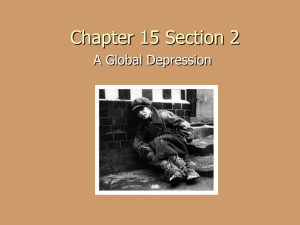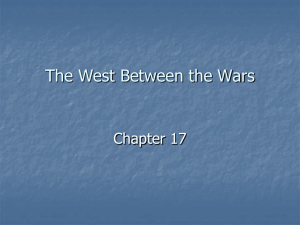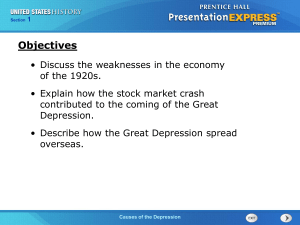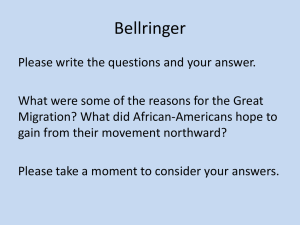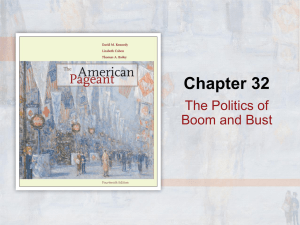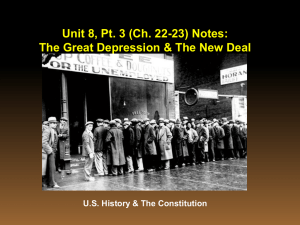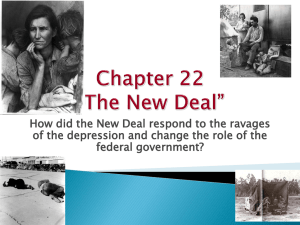Australian History_The Great Depression
advertisement
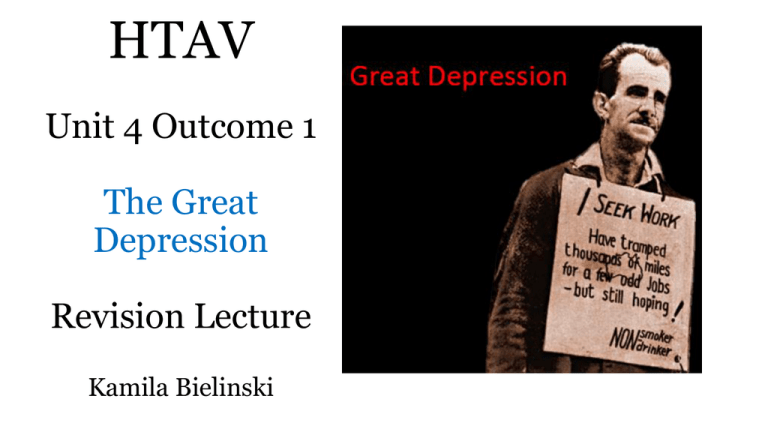
HTAV Unit 4 Outcome 1 The Great Depression Revision Lecture Kamila Bielinski Unemployed men receiving food handouts from a charity A NSW dole camp during the Depression - a corrugated iron shed had become home. Unemployment Demonstrations Escapism – Sir Donald Bradman The Swaggie Shanty Towns Women Prime Minister James Scullin trying in vain to balance the Federal budget. Scullin tries his strength The Bulletin, July 1930 Jack Lang NSW Premier took drastic economic measures to avoid paying back debt to the Bank of England. His tactics led to his dismissal Jack Lang criticised for his economic policies ‘For God’s sake stop laughing this is serious!’ Cross Drew 1933 In the view of many this summed up Australians’ attitude to the crisis. Unit 4 AOS 1 The Great Depression Dot Points as per the Study Design: • an outline of the depression and the ways in which Australians responded to the crisis: (Impact & Response) • the extent to which the depression shook old certainties and provided opportunities for people to argue for change; • the extent to which the cohesion of Australian society was maintained or redefined by the experience of the crisis. Unit 4 AOS 1 The Great Depression Key concepts: • Depression • Social cohesion • Disharmony • Responses from groups • • • • Urban Working Class Middle Class Upper Class Gender Metalanguage • Borrowed prosperity • Inequality • Economic expansion • Urban boom • Recession • Depression • Wall Street Crash • Psychological Stress • SUSSO • Destitution • DOLE • Charity • Escapism • Phar Lap • Bodyline (Cricket) • SHANTY TOWNS Unit 4 AOS 1 The Great Depression Unit 4 AOS 1 The Great Depression • Suggested Historians – • Potts • Spencely • Lowenstien • Blainey • Cannon and Tudball • McCalman • Spearrit • Cottell Unit 4 AOS 1 The Great Depression Where are we heading…? • We begin at the start of 1927 with the decline of the economy and discuss how we had a ‘borrowed prosperity' • Then move into the Wall Street Crash and the effect it had on Australia Government plans and Otto Neimeyer coming over to insist on a Deflationary course of action. • Evictions, loss of jobs, shantytowns, living in slums and the effect this had on the working classes. • What happened to the middle and upper classes • Charities and their role • Women and Children • Strikes, unions, the rise of the Communist party and the New Guard • Recovery Unit 4 AOS 1 The Great Depression • What is this Great Depression 1929-1935? The Great Depression describes a period of economic downturn which affected most of the countries of the western world between 1929 and the mid 1930s. The strict definition of a depression is four quarters (1 year) in which the economy shrinks or contracts instead of growing. In normal times, the economy of a country increases in value each quarter. If growth does not take place over two quarters (6 months) then an economy is said to be in recession, and for 4 quarters it is a depression. Unit 4 AOS 1 The Great Depression 1. A depression is characterised by the following: • A decline in demand for goods • A decline in business activity and production and possibly business collapse • Fall in prices for rural produce • unemployment • defaulting on mortgages, inability to pay rent, inability to buy basic necessities such as food and clothing • increasing pressure on charities, illness, psychological problems, some increase in petty crime. • The depression was certainly a time of misery for some possibly as many as 30% to 40% of the population. Unit 4 AOS 1 The Great Depression 2. A depression is characterised by the following: • The depression in Australia also led to great political upheaval and instability. When times are tough, people always look for someone to blame and it is usually the government. • Disagreement over who was to blame and how the depression could be ‘fixed’ led to over 25 elections, state and federal, (most resulting in a change of government) between 1929 and 1935. Unit 4 AOS 1 The Great Depression 1. HOWEVER it is important to remember : • Not everyone suffered in the depression! • Because prices fell more than wages, those who remained in work (up to 70% of the population), were actually better off. Moreover, some people really prospered in the depression (e.g. Cinema owners – escapism). Unit 4 AOS 1 The Great Depression 2. HOWEVER it is important to remember : • That even among those who suffered unemployment and poverty there were many positive experiences. There are stories of families helping each other out, of remarkable charity work, most of it voluntary, of people developing new skills and learning to ‘make do’ (Potts). Unit 4 AOS 1 The Great Depression DOT POINT 1. An outline of the Depression and its impact and the way people responded Unit 4 AOS 1 The Great Depression Impact and Response • Migrants • Urban Working Class • Women • Upper Class • Political groups • Aborigines Ways of Coping Unit 4 AOS 1 The Great Depression Politically Socially Union membership increased by 1932 Had sing-alongs Anti-eviction groups Shared what they had Some joined the Communist and Socialist parties Went to the beach or top the races and bought cheap seats at the cinema Strikes Some jumped the rattler with mates and had a bit of an adventure Many men and unions argued that women were taking their jobs Noel Counihan (social realism) painted workers, the poor , Aborigines and prostitutes (minority groups) depicting the injustices and poverty of the Depression. His work offended the world of ‘high art’. Jack Lang fought for the battler but lost his seat in NSW Violent clashes against opposing groups such as the New Guard • • • • • • • • Unit 4 AOS 1 Was everyone The Great Depression affected the same way? Not all people experienced unemployment or extreme poverty. For some it was an initial crisis, but they managed to deal with it periodically Women could find work, but for less pay. By 1933 25% of workers were women and only 15% of women were unemployed – males 26% by 1932. Some children found work when they lied about their age Some found part-time or sporadic work Some managed to access the SUSSO or handouts Others left their family to ease the burden Some sought family support Unit 4 AOS 1 The Great Depression Lower Class • "Widespread economic distress" working class Historian Marilyn Lake • Winston Stradher points out that “As families were evicted … shanty towns emerged” • “As the Depression deepened, symptoms of moral decay appeared”- Janet McCalman • Joan Coxsedge – “a pittance to keep the body and soul alive” in relation to the Susso Unit 4 AOS 1 The Great Depression Upper Class • Those who were in full time employment experienced an improvement in real living standards, rather than a diminution” – Spencely • “ The rich continued to remain rich” – Drew Cottle • “ Able to live a comfortable life through the depression” Winston Stradher • “Heralded not a period of misery, but one of prosperity and material progress” Spencely • Mrs. Eustace sent her children to Paris for the year • “we able to buy on a failing market, food, travel, clothing etc. was very cheap those years” J. Atkinson • Kambala student recalls- “none of the girls walked to school… driven by parents chauffeurs” • Sidney Myer Christmas Appeals Unit 4 AOS 1 The Great Depression Government • The government were in dead-shit trouble- Potts • R. Engwerda – “The general reaction was to reduce spending by as much as possible” • ALP split up • Geoffrey Spenceley argues that “There had been much dithering, disagreement and delay in the Labor government” • Wendy Lowenstein - “Government relief was a charity which many found difficult to accept” Unit 4 AOS 1 The Great Depression Women • 70% were employed- Spencley • “Women are in ruthless competition with men”Journalist William Denning • Stanley Seymour Argyle- premier who closed sole-women hiring shops Unit 4 AOS 1 The Great Depression DOT POINT 2. The extent to which the depression experience shook old certainties and provided opportunities that brought change – change to Australian society, change to individuals, change to the ideas and values that underpinned society etc. You are also to think about whether the depression gave people the opportunity to argue for change. Unit 4 AOS 1 The Great Depression Old certainties shaken by the crisis • Democracy • Political stability * • Economic system • Gender roles • Working Man’s Paradise • Job security • Egalitarian society • Secure Housing * • Social structures and values * • Relationship with Britain Unit 4 AOS 1 The Great Depression What is meant by shake old certainties? - What this dot point generally asks you to think about is the extent to which the depression brought about change. ‘shaking old certainties’ refers to the impact of the depression on ideas, values, institutions, social, political structures and the economy as well as ways of doing things that people accepted as normal. Unit 4 AOS 1 The Great Depression What is meant by shake old certainties? • It should be noted that most upheavals rarely cause permanent change. Real social change on a national level is slow and gradual. The fundamentals on which society was based remained largely the same. • You are aware of the fundamentals on which Australian was based at federation (NRC). In this topic you are asked to think about: • Whether old certainties were shaken or even changed by the depression experience? • What sorts of certainties were shaken or changed? (Job security, standards of living, family unity, the economic system, the political system, reliance on government) • What certainties or aspects of society remained unaffected? • Whether the changes were permanent or temporary, superficial or deep seated? Unit 4 AOS 1 The Great Depression The Political System and its stability • Change is always a part of political life, but there seemed to be a great deal more political change during the depression years. There were several events or movements which led people’s certainties about politics to be shaken. • The large number of elections, almost all of which resulted in a change of government. This created a feeling of insecurity. • The split in the ALP, for the second time. This shook the confidence of many working class people in the party that they believed would look after them. • The irregular response of Jack Lang to the matter of interest payments to Britain. • The sacking of Premier Jack Lang by the Governor of NSW, Sir Phillip Game. • The growth of extremist organizations at the left and right of the political spectrum. • The government of Western Australia attempted to secede from the Australian Commonwealth in 1933. • The region of the Riverina wanted to set itself up as a separate state. Unit 4 AOS 1 The Great Depression The Political System and its stability Real change? • The political system was shaken but not overturned. • In spite of these upheavals, the political system remained the same • Australia remained a democracy. • There were still two major parties – ALP and Conservatives (UAP) • As the crisis passed, support for extreme right and left wing groups fizzled out. • The WA secession movement also fizzled out. BUT • The federal government took a greater role in the regulation of the economy through the establishment of the Federal Loan Council and this continued after the depression. • The federal government also took over the payment of unemployment benefits from the states. This continued after the depression. Secure Housing Unit 4 AOS 1 The Great Depression • Before the depression, fewer than 50% of Australians owned their own home. • Loss of secure accommodation was often the most dramatic consequence of unemployment According to David Potts, the reactions of unemployed renters varied: • Some landlords evicted non-paying tenants • Some landlords lowered rents and allowed good tenants to remain. • Some tenants looked for cheaper housing in smaller houses or outer suburbs. • Some tenants moved in with relatives. • At the worst stage of the depression it is estimated that 40,000 to 70,000 people were living in makeshift accommodation or were on the road. • 1935 was the worst year for banks repossessing homes because people had defaulted on mortgages. • Those who had to sell houses sold them cheaply and there were others willing to buy them. Essendon businessman Jack Watts bought up 10 cottages cheaply in North Melbourne and Flemington during the 1930s. Secure Housing Unit 4 AOS 1 The Great Depression Real Change? • Security about housing was shaken for some, but not overturned. • If anything, the experience of homelessness actually led more Australians to value home ownership which grew to about 70% by 1960. Many became determined never to be homeless again. (e.g. Agnes Johnstone) • By 1939, most of the shanty towns had disappeared. As the economy improved, building of houses increased and more rental housing became available. On the other hand, there were people who built new houses during the depression taking advantage of cheaper materials and lower wages for workers. (AV Jennings). James McCabe, a businessman from North Melbourne, built a large house in Brighton in 1931. • The experiences of homelessness led governments to take greater responsibility for housing. The Housing Commission of Victoria was established in 1938 and the public Housing Commission of NSW started in 1940. For the nation as a whole, longer term improvements in housing, largely came as a result of the depression. Unit 4 AOS 1 The Great Depression • • • • • Social structures and values The basic social structure and values that underpinned Australian society did not change significantly. Some aspects were strengthened, others were challenged. Family life – threatened to some degree – break-up, children in orphanages, fathers on the road, slight increase in divorce rate BUT little long term change. Role of women – women took on greater responsibility, campaigns for better pay for women (led by Muriel Heagney) BUT men’s wages still higher, women had few rights. Egalitarianism – Australia had never been a classless society but there had been a belief that everyone had the opportunity to do well and improve. This belief was challenged during the depression. Those at the bottom of the social and economic ladder – the unskilled, the poorly educated, those in rented accommodation, those without savings were the worst hit by the depression. Many people questioned the idea that Australia was an egalitarian society. • • • • Unit 4 AOS 1 The Great Depression Social structures and values White Australia was strengthened.– racist attitudes towards Aborigines, Chinese, Europeans even some British became more severe. Competition for jobs brought out racist tendencies. Treatment of Aborigines became worse – children taken from families. Education – school leaving ages, especially for girls, fell during the depression years. Most private schools also reported a decline in enrolments. Boarding schools were particularly affected because of the impact of the depression on the farming communities. However, by 1937 enrolments were again rising. Social responsibility - There was a strengthening in the amount of charitable work and in the sense of social responsibility, but only among a section of the population. Families, church groups and organizations such as the Country Women’s Association raised funds, provided meals, assisted with clothing and shelter. Groups such as the Unemployed Workers’ Movement helped families to resist evictions. Unit 4 AOS 1 The Great Depression To sum up … Some of these changes such as: • the increasing role of the federal government in terms of economic regulation and welfare, • Some restructuring of the economy, • BUT the majority of the change brought by the depression was temporary. As the economy began to revive, most of the evidence suggests that normal patterns of life - employment, housing and family life returned to the pre depression situation. Unit 4 AOS 1 The Great Depression To sum up … • Some people, interviewed by researchers such as Lowenstein, Potts, Broomhill and McCalman, say that were scarred for life by their experiences of unemployment. Others claim that the depression experience made them stronger and more determined to be successful. Overall, however, it appears that the depression did not have a permanent impact on the certainties on which Australian life had been based since federation – • There was still strong loyalty to Britain (shown by the mourning at the death of King George V and the public celebration of the coronation of King George V1 in 1937.) Australians were still passionately interested in sport. The economy was still based largely on primary produce yet Australia was still an urban nation. • The depression could be said to have shaken old certainties but not to have removed them completely. Changes by 1937-39 Unit 4 AOS 1 The Great Depression Short Term Long Term By 1932 1/3 of the country was unemployed. However 2/3 were better off with lower prices. Governments made plans to ensure an economic depression like this would not occur again Price of wool and wheat fell dramatically as Australia paid back its overseas loans Some people had bitter memories Some people lost their homes whilst other were given extra time on the mortgages Whilst other felt it taught them how to budget and make do Increase infant mortality and malnutrition People were politicized and realised the power of activism Nature if the breadwinner being Dad changed, loss of dignity as women and children became the wage earners. Increased stress due to uncertainty For Aborigines, children were taken from them, whole families were broken and as a result became even more disenfranchised Rise in union and political party activity whilst Governments became more aware of the need for social responsibility with pensions etc. For many there were long term debts to be repaid, lost houses to be replaced, severed families to be connected and confidence restored to those who lost their dignity through continual unemployment. More dependence on charities and the SUSSO Unit 4 AOS 1 The Great Depression DOT POINT 3. The extent to which the depression led to greater or less cohesion – that is co-operation, sticking together, mutual support. There is evidence that the depression experience led to division and mistrust. There is also abundant evidence of extraordinary co-operation between those who were suffering and those who were better off. One example: It was known that homeless men used to gather in the laneways behind city hotels and restaurants and rummage in the dustbins looking for food. Several restaurant owners began the nightly practice of putting good quality food on the tops of their bins. Unit 4 AOS 1 The Great Depression Cohesion maintained or redefined for? • Migrants • Urban Working Class • Women • Upper Class • Political groups Unit 4 AOS 1 The Great Depression Working Class • Potts “the same boat” …. “sharing between nieghbours”… “pulling together in the face of adversity.” • J. Atkinson - “were able to help close relations and others” • Lowenstein - “to look after Number One” Unit 4 AOS 1 The Great Depression Upper Class • Drew Cottle - “stood for preserving the existing social order” • Mrs. Pont - “allowed one to know who was who” • Potts “less snobbery and more comradeship” … “leveled out” Unit 4 AOS 1 The Great Depression Government • Geoffrey Spenceley - “There had been much dithering, disagreement and delay in the Labor government” • Historian R. Engwerda - “A small group of conservatives led by Joe Lyons and another group of radical Jack Lang supporters deserted the party.” Unit 4 AOS 1 The Great Depression Some Tips! Juxtaposition of historical perspectives A highly capable history student is able to juxtapose historical points of view. This shows the assessor that you are able to analyse and acknowledge varying historical perspectives in your argument. Some Samples – 1. Marilyn Lake states that “Widespread economic distress” was a problem in Australia, yet in stark contrast Historian Spencley identified that “70% of Australia was employed” during the depression. 2. However contrary to Historian Drew Cottle’s view is Historian David Potts who is of the opinion that the upper class showed less snobbery and more comradeship.” Remember to… Unit 4 AOS 1 The Great Depression Do Not to do! Use accurate dates and statistics Generalise - there are many groups of people who were affected in a variety of ways, everybody had their own experiences. Include anecdotes and peoples’ names Do not just focus on the working class or unemployed Include historical perspectives Do not forget to include political, social and economic information Juxtapose historical points of view Do not stress too much. If you practice, you cant help but succeed. Use the metalanguage of the period Address the question and keep referring to it throughout the body of your work Look at many groups in society Writes as many practice essays before the exam as possible so you feel comfortable with your time management.
